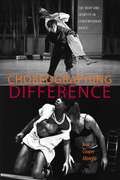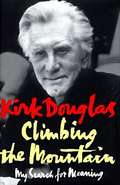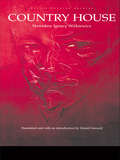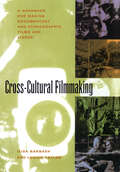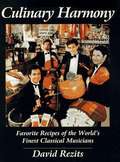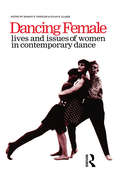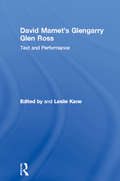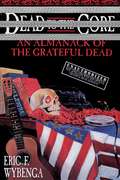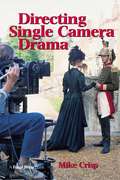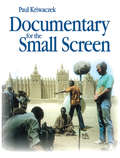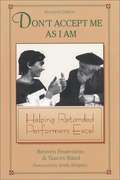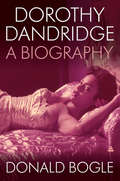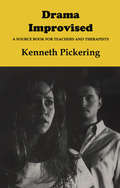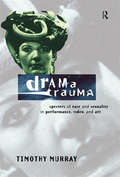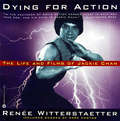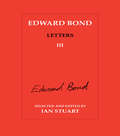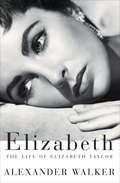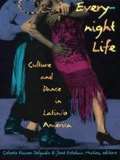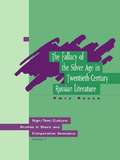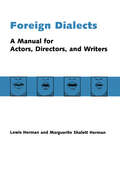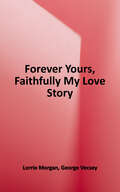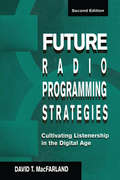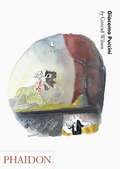- Table View
- List View
Choreographing Difference: The Body and Identity in Contemporary Dance
by Ann Cooper AlbrightThe choreographies of Bill T. Jones, Cleveland Ballet Dancing Wheels, Zab Maboungou, David Dorfman, Marie Chouinard, Jawole Willa Jo Zollar, and others, have helped establish dance as a crucial discourse of the 90s. These dancers, Ann Cooper Albright argues, are asking the audience to see the body as a source of cultural identity -- a physical presence that moves with and through its gendered, racial, and social meanings.Through her articulate and nuanced analysis of contemporary choreography, Albright shows how the dancing body shifts conventions of representation and provides a critical example of the dialectical relationship between cultures and the bodies that inhabit them. As a dancer, feminist, and philosopher, Albright turns to the material experience of bodies, not just the body as a figure or metaphor, to understand how cultural representation becomes embedded in the body. In arguing for the intelligence of bodies, Choreographing Difference is itself a testimonial, giving voice to some important political, moral, and artistic questions of our time.Ebook Edition Note: All images have been redacted.
Climbing the Mountain: My Search for Meaning
by Kirk DouglasThe famous actor's quest not only for the meaning of life and his own relationship to God, but for his own identity as a Jew.
Country House: Polish Theatre Archive
by Stanislav I. Witkiewicz D. GerouldCountry House, a ''comedy with corpses,'' is a wicked subversion of all those realistic psychological dramas of jealousy, adultery, murder and suicide that ask to be taken seriously. Witkacy's send-up assumes the form of a ghost story full of surprises, in the course of which an entire family of four is gleefully dispatched to the other world. When it was first performed in 1923 in Torun, Country House was judged unsuitable for the general public because it derided moral, social and dramatic convention. Three years later, as directed by the playwright himself in Lwów, the drama proved an unexpected success with audiences (although it only ran for four nights) and ever since has been among Witkacy's most frequently performed works. Today we can appreciate Country House not only as a systematic demolition of stage realism, but also as an anxious probing of the elusive boundaries between life and death, exposing the ''dark places'' of the human psyche that make us laugh nervously.
Cross-Cultural Filmmaking: A Handbook for Making Documentary and Ethnographic Films and Videos
by Lucien Taylor Ilisa BarbashThis extraordinary handbook was inspired by the distinctive concerns of anthropologists and others who film people in the field. The authors cover the practical, technical, and theoretical aspects of filming, from fundraising to exhibition, in lucid and complete detail—information never before assembled in one place. The first section discusses filmmaking styles and the assumptions that frequently hide unacknowledged behind them, as well as the practical and ethical issues involved in moving from fieldwork to filmmaking. The second section concisely and clearly explains the technical aspects, including how to select and use equipment, how to shoot film and video, and the reasons for choosing one or the other, and how to record sound. Finally, the third section outlines the entire process of filmmaking: preproduction, production, postproduction, and distribution. Filled with useful illustrations and covering documentary and ethnographic filmmaking of all kinds, Cross-Cultural Filmmaking will be as essential to the anthropologist or independent documentarian on location as to the student in the classroom.
Culinary Harmony: Favorite Recipes of the World's Finest Classical Musicians
by David RezitsA detailed biography accompanies each musician, allowing readers to get to know the artists, while mastering their tasty recipes.
Dancing Female (Choreography and Dance Studies Series #Vol. 12)
by Sharon E. Friedler Susan B. GlazerFirst Published in 1997. Routledge is an imprint of Taylor & Francis, an informa company.
David Mamet's Glengarry Glen Ross: Text and Performance (Studies In Modern Drama Ser. #Vol. 8)
by Leslie KaneFirst published in 1997. Routledge is an imprint of Taylor & Francis, an informa company.
David Rudkin: An Expository Study of his Drama 1959-1994
by David Ian Rabey David I. RabeyDr. Rabey's profound critical study of David Rudkin's drama constitutes an in-depth evaluation of this unique dramatist, re-assessed in the light of his bi-sexuality and Anglo-Irish origins. This key study includes insights from noted performers of Rudkin's work, including Ian Hogg, Peter McEnery, Ian McDiarmid, Gerard Murphy, and Charlotte Cornwell. It is a fully authorized study with exclusive reference to archival material which includes some frank and urgent interview contributions from the dramatist himself, who is usually deemed reclusive. It is enhanced by Dr. Rabey's own experience of Wales, Ireland, and the English Black Country for his exposition of Rudkin's mythic sense of Celtic and Mercian history.
Dead to the Core: An Almanack of the Grateful Dead
by Eric WybengaIt is part reference, part critical companion to the best the Dead have to offer, a work liberally stocked with trivia, lore, humor, and arcana. No Head "farmer" wanting to reap the dankest of the Dead kind will want to be without this essential resource. Includes... Show-a-day seasonal calendars; Detailed show reviews from key years; Musical and lyrical analyses of the Dead's core tunes; Annotated lists of hot versions of key tunes; Capsule reviews of shows from throughout the Dead's career; Personal anecdotes and observations from Deadheads; A guide to the best Dead-related sites on the Internet; In-depth essays on the Dead's prime eras... And much, much more, including the Dead-Dylan connection, the Dead and Garcia's place in the musical universe, the Deadhead pantheon, and tour lore.
Directing Single Camera Drama
by Mike CrispDirecting drama for the single camera is like no other form of Filmmaking, or any other medium involving actors. Experience in documentary or theatre may provide useful clues, but the techniques for drama film directors, although not basically complicated, are unique. Experienced directors in other spheres of directing will find this book invaluable if they wish to move into single camera drama, as will students setting out on their careers. Directing Single Camera Drama is a synthesis of the skills required to bring drama to the screen. Directing drama for the single camera is like no other form of Filmmaking, or any other medium involving actors. Experience in documentary or theatre may provide useful clues, but the techniques for drama film directors, although not basically complicated, are unique. Experienced directors in other spheres of directing will find this book invaluable if they wish to move into single camera drama, as will students setting out on their careers. Directing Single Camera Drama is a synthesis of the skills required to bring drama to the screen.A unique feature of the book is the inclusion of ten short film drama scripts which need only half a day's rehearsal and one short day's filming. Each have their various technical demands, and they are arranged in ascending order of dramatic and creative difficulty. They can be photocopied and used for non-broadcast training drama exercises. Mike Crisp worked as Production Manager, and later Director, on many classic BBC TV series, such as Fawlty Towers, Porridge and Steptoe and Son. He was, for 10 years, a senior producer with the BBC's TV Training Department. He is the author of The Practical Director now in its second edition and also published by Focal Press.Reviews:'Directors in other spheres of directing who wish to move into single camera drama will find this book invaluable, as will students setting out on their careers.'Voice of the Listener
Documentary for the Small Screen
by Paul KriwaczekFilm and video have grown to be as significant in our time as books, newspapers and magazines. Documentary film-making is fast becoming as important and useful a skill as the ability to write well. Like writing, it can be learned by anyone. Film and video have grown to be as significant in our time as books, newspapers and magazines. Documentary film-making is fast becoming as important and useful a skill as the ability to write well. Like writing, it can be learned by anyone.Documentary for the small screen is both for those who are new to documentary film-making but want to know how to create productions of a professional standard, as well as for those already working in the medium who wish to improve their skills by taking a closer look at the way they carry out their tasks. It is written in a logical, straightforward way, the first half taking the reader through an analysis of what documentary actually is, to constructing it through developing the story and assembling the appropriate building-blocks. In the second part, the pre-production stages of preparing proposals, costings and outlines, and researching the subject are all carefully examined, as are production planning and the shoot, followed by the post-production stages involved in editing and reviewing the completed film. Paul Kriwaczek is an award winning documentary maker who has a wealth of experience to pass on, having worked for many years at BBC Television where he wrote, directed and produced documentary, drama, music and science programmes.
Don't Accept Me as I Am: Helping Retarded Performers Excel
by Reuven Feuerstein Yaacov RandHow to help a retarded child develop, how mental retardation can be remediated.
Dorothy Dandridge: A Biography
by Donald BogleAvailable once again, the definitive biography of the pioneering Black performer—the first nominated for a Best Actress Academy Award—who broke new ground in Hollywood and helped transform American society in the years before Civil Rights movement—a remarkable woman of her time who also transcended it. “An ambitious, rigorously researched account of the long-ignored film star and chanteuse. . . . Bogle has fashioned a resonant history of a bygone era in Hollywood and passionately documented the contribution of one of its most dazzling and complex performers."—New York Times Book ReviewIn the segregated world of 1950s America, few celebrities were as talented, beautiful, glamorous, and ultimately influential as Dorothy Dandridge. Universally admired, she was Hollywood's first full-fledged Black movie star. Film historian Donald Bogle offers a panoramic portrait of Dorothy Dandridge’s extraordinary and ultimately tragic life and career, from her early years as a child performer in Cleveland, to her rise as a nightclub headliner and movie star, to her heartbreaking death at 42. Bogle reveals how this exceptionally talented and intensely ambitious entertainer broke down racial barriers by integrating some of America's hottest nightclubs and broke through Tinseltown’s glass ceiling. Along with her smash appearances at venues such as Harlem’s famed Cotton Club, Dorothy starred in numerous films, making history with her role in Otto Preminger’s Carmen Jones, playing opposite Harry Belafonte. Her performance earned her an Academy Award nomination for Best Actress—the first Oscar nod for a woman of color.But Dorothy’s wealth, fame, and success masked a reality fraught with contradiction and illusion. Struggling to find good roles professionally, uncomfortable with her image as a sex goddess, coping with the aftermath of two unhappy marriages and a string of unfulfilling affairs, and overwhelmed with guilt for her disabled daughter, Dorothy found herself emotionally and financially bankrupt—despair that ended in her untimely death.Woven from extensive research and unique interviews, as magnetic as the woman at its heart, Dorothy Dandridge captures this dazzling entertainer in all her complexity: her strength and vulnerability, her joy and her pain, her trials and her triumphs.
Drama Improvised: A Sourcebook for Teachers and Therapists
by Kenneth PickeringThis book provides a practical, accessible, and inexpensive guide to using improvisation in drama, which lies at the root of actor training, educational drama and drama therapy, in a wide variety of situations. It is useful for teachers, organizers of drama workshops, therapists and trainers.
Drama Trauma: Specters of Race and Sexuality in Performance, Video and Art
by Timothy MurrayIn this engaging cross-disciplinary study, Timothy Murray examines the artistic struggle over traumatic fantasies of race, gender, sexuality, and power. Establishing a retrospective dialogue between past and present, stage and video, Drama Trauma links the impact of trauma on recent political projects in performance and video with the specters of difference haunting Shakespeare's plays. The book provides close readings of cultural formations as diverse as Shakespearean drama, the Statue of Liberty, contemporary plays by women, African-American performance, and feminist interventions in video, performance and installation. The texts discussed include: * installations by Mary Kelly and Dawn Dedeaux, * plays by Ntozake Shange, Rochelle Owens, Adrienne Kennedy, Marsha Norman and Amiri Baraka * performances by Robbie McCauley, Jordan, Orlan, and Carmelita Tropicana * stage, film and video productions of King Lear, Othello, Romeo and Juliet and All's Well that Ends Well.
Dying for Action: The Life and Films of Jackie Chan
by Renée WitterstaetterA biography of action film star Jackie Chan.
Edward Bond: Letters 3
by Ian StuartFirst Published in 1997. Routledge is an imprint of Taylor & Francis, an informa company.
Elizabeth: The Life of Elizabeth Taylor (Isis Large Print Ser.)
by Alexander WalkerA serious and in-depth look at one of the great legends of Hollywood by the London film critic and author of Audrey: Her Real Story. Elizabeth Taylor was perhaps the most “public” of the great stars: an Oscar-winning actress who lived her entire life in the glare of the spotlights. Much has been written about her, but now—with the readability, sensitivity, and thoroughness that have made his previous biographies bestsellers—Alexander Walker explores the roots of Taylor’s extraordinary personality and extraordinary life. Here is a life to rival the very movies she played in, told with immense candor, wit, and sympathy: from her privileged London childhood, the enormous influence of her strong-willed mother, and her swift rise to stardom in such films as National Velvet, A Place in the Sun, and the catastrophe-ridden Cleopatra; to her six husbands, her desperate need to love and be loved, her obsession with jewelry, and the amazing resilience that helped her weather not only condemnation for “the most public adultery in history,” but also dramatic illnesses that brought her to the verge of death—and, according to her, beyond. Using scores of unpublished documents and interviews with those who knew Taylor best, as well as his own meetings with her over thirty years, Alexander Walker recreates the comedies and tragedies in the life of a woman whose rewards and scandals have become the stuff of legend.
Everynight Life: Culture and Dance in Latin/o America
by José Esteban Muñoz Celeste Fraser DelgadoThe function of dance in Latin/o American culture is the focus of the essays collected in Everynight Life. The contributors interpret how Latin/o culture expresses itself through dance, approaching the material from the varying perspectives of literary, cultural, dance, performance, queer, and feminist studies. Viewing dance as privileged sites of identity formation and cultural resistance in Latin/o America, Everynight Life translates the motion of bodies into speech, and the gestures of dance into a provocative socio-political grammar.This anthology looks at many modes of dance--including salsa, merengue, cumbia, rumba, mambo, tango, samba, and norteño--as models for the interplay of cultural memory and regional conflict. Barbara Browning's essay on capoeira, for instance, demonstrates how dance has been used as a literal form of resistance, while José Piedra explores the meanings conveyed by women of color dancing the rumba. Pieces such as Gustavo Perez Fírmat's "I Came, I Saw, I Conga'd" and Jorge Salessi's "Medics, Crooks, and Tango Queens" illustrate the lively scope of this volume's subject matter.Contributors. Barbara Browning, Celeste Fraser Delgado, Jane C. Desmond, Mayra Santos Febres, Juan Carlos Quintero Herencia, Josh Kun, Ana M. López, José Esteban Muñoz, José Piedra, Gustavo Perez Fírmat, Augusto C. Puleo, David Román, Jorge Salessi, Alberto Sandoval
Fallacy of Silver Age
by Omry RonenIn this study, Ronen critically examines the term "Silver Age", which over the years has gained such wide currency among historians and connoisseurs of 20th century Russian culture. The author traces the origin and the controversial development of what he condemns as an influential misnomer. Ronen sets out to debunk the myth that attributes invention of the term to Nikolai Berdiaev, and in turn traces this widely used catchword in the critical idiom from an abscure, avante-garde manifesto to the present day. He lays to rest the use of the term which he sees as the most misleading constituent of Russia's contemporary cultural self-awareness and self-assessment.
Foreign Dialects: A Manual for Actors, Directors, and Writers
by Lewis Herman Marquerite Shalett HermanMost actors and directors have struggled with the problem of needing to imitate foreign dialects. Marguerite and Lewis Herman have created an essential tool for actors, directors and writers aiming toward the most authentic performances possible.Foreign Dialects contains an extensive repertoire of dialects that will assist the actor in the preparation for the most difficult foreign roles. Now in paperback, this classic text offers the director or producer a quick, convenient aid for correcting actors and evaluating applicants for authenticity and dialect ability. In addition, it guides those writing fiction as well as radio, movie, and television scripts. Thirty foreign dialects are provided, with character studies, speech peculiarities, and examples of the dialects in easy-to-read phonetic monologues--including Cockney, British, Irish, Scottish, French, German, Spanish, Swedish, Polish, Greek and Yiddish.
Forever Yours, Faithfully: My Love Story
by Lorrie MorganBy turns passionate and desperate, tragic and triumphant--the life of Lorrie Morgan could easily have been lifted from the lyrics of a classic country song. Now, in Forever Yours, Faithfully, Lorrie shares all the pleasure and the pain of her remarkable career and her turbulent, consuming love for doomed, brilliant blue-grass star, Keith Whitely. Lorrie Morgan was born to be a country music star. Thanks to a father who was also a Grand Ole Opry legend, Lorrie grew up in the shadows of such country greats as Minnie Pearl and Roy Acuff. Inspired by such talent and nurtured in a stable home, she sang at the Opry when she was only thirteen years old. In a voice all her own, Lorrie takes us inside the country music world where she would rise to become Nashville gold. Over the next several years, Lorrie's home life was to become a lot less stable. When Lorrie was twenty-two years old, she heard a voice on the radio--and fell under its seductive spell. That voice belonged to singer Keith Whitely. They soon met, left their respective marriages, and started a life that Lorrie hoped would be "happily ever after." Yet it was a relationship marred by dark moods, drinking, and drugs, as Lorrie, blinded by devotion, refused to see that she was hopelessly in love with a chronic alcoholic. She stayed by his side until his untimely death in 1989--only to be hit with a second blow: the shocking news of Keith's infidelities. With amazing insight and candor, Lorrie opens her heart, answering such personal questions as Who was with Keith when he died? What actually killed him? How does one reconcile the "man of your dreams" with the man in real life? And perhaps most important: Can he be forgiven? Fortunately, Lorrie's life did not end after Keith's death. Her star went on to shine even brighter. She rose to superstar status as a singer and, eventually, true love came calling again. Beloved, betrayed, and ultimately resilient, Lorrie Morgan has written a painfully honest memoir about rising above and moving on. Forever Yours, Faithfully resonates with emotion and the power of the human spirit.
Future Radio Programming Strategies: Cultivating Listenership in the Digital Age (Routledge Communication Series)
by David MacFarlandFundamental beliefs is what the reader will be exploring here -- a common understanding of what the radio enterprise should be about: entertainment and information. A major thrust of this book is to arrive at a set of fundamental beliefs about the values and realities of the radio business in regard to entertainment programming -- a set of beliefs that may or may not be right, true, or forever, but that might at least provide a basis for developing programming strategies. This second edition of Future Radio Programming Strategies seeks to answer the question: "What do listeners really want from radio?" Some of the answers are derived from "users-and-gratifications" research in the mass media. Instead of focusing on what mass media do to people, the users-and-gratifications perspective seeks to discover what people do with mass media. The functionalist viewpoint of such research basically says that a medium is best defined by how people use it. Having looked at some of the audience research that comes from sources other than the standard ratings companies, the book then goes on to demonstrate new ways that formats, production procedures, and announcing styles can meet audience needs and desires. Although the volume concludes with several original methods for selecting and presenting airplay music based on the audience's moods and emotional needs, it does not insist upon a singular, formulaic approach for constructing or modifying a music format. Instead, it attempts to involve the reader in thinking through the process of format development. Two audio tapes are also available for use with the book. The tapes contain nearly 3 hours of important, detailed information and provocative points from the book. Exclusive audio examples include: * the sense of acoustic space in music; * hi-fi versus lo-fi listening environments; * subjective perception of the announcer's distance from the listener; * audio editing rates; * comparison of luxury versus inexpensive car listening experiences; and * the components of emotions that are expressed vocally. The tapes also include new sections about the threats to traditional radio from specialized digital audio services, competition for the listener's attention from computer-based media, and additional proof of how music can be chosen on the basis of listeners' emotional reactions and mood needs.
George Cukor: A Double Life
by Patrick McGilliganOne of the highest-paid studio contract directors of his time, George Cukor was nominated five times for an Academy Award as Best Director. In publicity and mystique he was dubbed the &“women&’s director&” for guiding the most sensitive leading ladies to immortal performances, including Greta Garbo, Ingrid Bergman, Judy Garland, and—in ten films, among them The Philadelphia Story and Adam&’s Rib—his lifelong friend and collaborator Katharine Hepburn. But behind the &“women&’s director&” label lurked the open secret that set Cukor apart from a generally macho fraternity of directors: he was a homosexual, a rarity among the top echelon. Patrick McGilligan&’s biography reveals how Cukor persevered within a system fraught with bigotry while becoming one of Hollywood&’s consummate filmmakers.
Giacomo Puccini
by Conrad WilsonGiacomo Puccini (1858--1924), composer of such popular operas as La Bohème and Madame Butterfly, is most renowned for his gift as a melodist. With his final opera, Turandot, Puccini composed the last Italian work in the genre to hold a firm place in the international repertoire. The author draws attention to the felicity, daring and extraordinary colouring of his music, countering the view held during Puccini's lifetime that he was a retrogressive who aimed to shock. Puccini is shown to have been a new force in musical drama, and yet a man who remained insecure about his creative powers. Conrad Wilson's book is a polemical, passionate and rational attempt to set the man from Lucca among the immortal greats.
